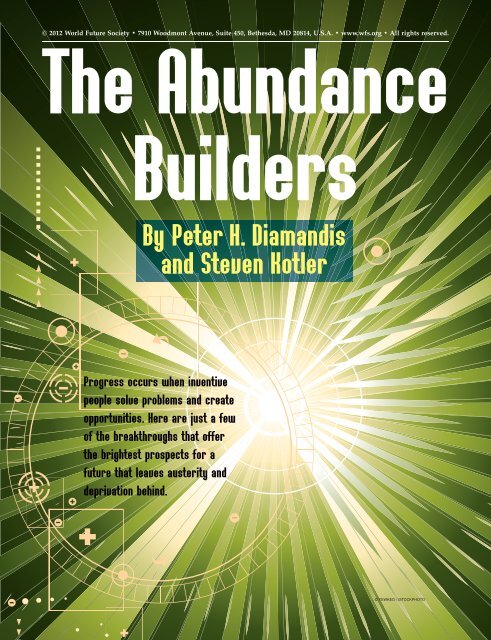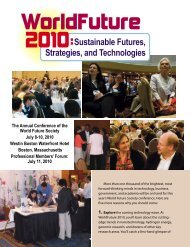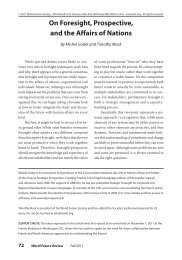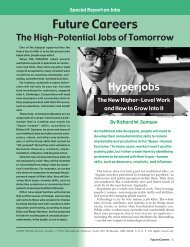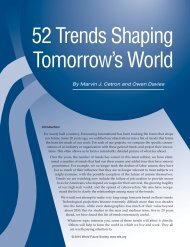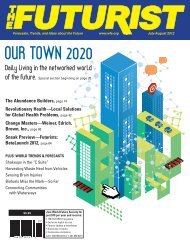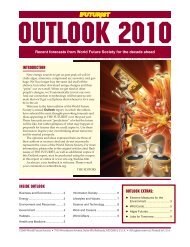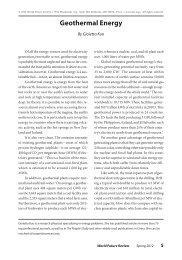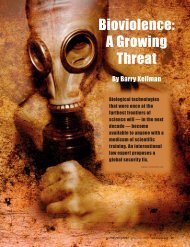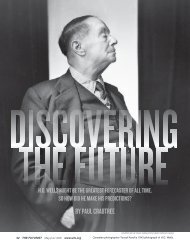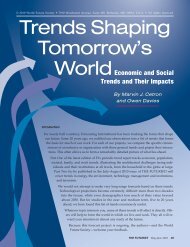The Abundance Builders - World Future Society
The Abundance Builders - World Future Society
The Abundance Builders - World Future Society
Create successful ePaper yourself
Turn your PDF publications into a flip-book with our unique Google optimized e-Paper software.
© 2012 <strong>World</strong> <strong>Future</strong> <strong>Society</strong> • 7910 Woodmont Avenue, Suite 450, Bethesda, MD 20814, U.S.A. • www.wfs.org • All rights reserved.<strong>The</strong> <strong>Abundance</strong><strong>Builders</strong>By Peter H. Diamandisand Steven KotlerProgress occurs when inventivepeople solve problems and createopportunities. Here are just a fewof the breakthroughs that offerthe brightest prospects for afuture that leaves austerity anddeprivation behind.© YEWKEO / ISTOCKPHOTO
<strong>The</strong> potential for abundance—that is, pervasive opportunitiesfor prosperity, as opposed tolives of luxury for all—depends onour ability to exploit breakthroughsin key exponentiallygrowing fields. This article will explorea few of the leaders who havedevoted their lives to creating thisnew world of abundance.Biotechnology:<strong>The</strong> Code BreakersIn 1990, the U.S. Department ofEnergy and the National Institutes ofHealth jointly launched the HumanGenome Project, a 15-year programwhose goal was to sequence the3 billion base pairs that make up thehuman genome. Some thought theproject impossible. Others felt itwould take a half century to complete.Everyone agreed it would beexpensive. A budget of $10 billionwas set aside, but many felt it wasn’tenough. <strong>The</strong>y might still be feelingoil or any other kind of fuel. Interestedin pure octane? Aviation gasoline?Diesel? No problem. Give yourdesigner the proper DNA instructionsand let biology do the rest.To further this dream, Venter hasalso spent the past five years sailinghis research yacht, Sorcerer II, aroundthe globe, scooping up algae alongthe way. <strong>The</strong> algae is then runthrough a DNA sequencing machine.Using this technique, Venter hasbuilt a library of more than 40 milliondifferent genes, which he cannow call upon for designing hisfuture biofuels.Venter wants to use similar methodsto design human vaccineswithin 24 hours rather than the twoto three months currently required.He’s thinking about engineeringfood crops with a 50-fold productionimprovement over today’s agriculture.Low-cost fuels, high-performingvaccines, and ultra-yield agricultureare just three of the reasons thatthe exponential growth of biotechthisway, too, except that, in 2000,J. Craig Venter decided to get intothe race.It wasn’t even much of a race.Building on work that had come before,Venter and his company,Celera, delivered a fully sequencedhuman genome in less than one yearfor just under $100 million.As an encore, in May 2010, Venterannounced his next success: the creationof a synthetic life-form. He describedit as “the first self-replicatingspecies we’ve had on the planetwhose parent is a computer.” In lessthan 10 years, Venter both unlockedthe human genome and created theworld’s first synthetic life-form—geniuswith repeat success.Venter’s actual goal is the creationof a very specific kind of syntheticlife: the kind that can manufactureultra-low-cost fuels. Rather thandrilling into the earth to extract oil,Venter is working on novel algae,whose molecular machinery can takecarbon dioxide and water and createPHOTOS: J. CRAIG VENTER INSTITUTEDr. J. Craig Venterat the microscopeonboard Sorcerer IIExpedition.<strong>The</strong> Sorcerer II atanchor in theMarquesas Islandsin French Polynesia.1 <strong>The</strong> <strong>Abundance</strong> <strong>Builders</strong>
nology is critical to creating a worldof abundance. Let’s turn to the nextcategory on our list.Networks and Sensors:<strong>The</strong> ConnectorsDuring his graduatestudent years, Vint Cerf,chief Internet evangelistfor Google, worked in thenetworking group thatconnected the first twonodes of the AdvancedResearch Projects AgencyNetwork (Arpanet). Next,he became a programmanager for the DefenseAdvanced Research ProjectsAgency (DARPA), funding variousgroups to develop Internetprotocol technology. During thelate 1980s, when the Internet beganits transition to a commercialopportunity, Cerf moved tothe long-distance telephone companyMCI, where he engineered thefirst commercial e‐mail service. Hethen joined ICANN (Internet Corporationfor Assigned Names andNumbers), the key U.S. governanceorganization for the Web, and servedas chairman for more than a decade.For all these reasons, Cerf is consideredone of the “fathers of the Internet.”<strong>The</strong>se days, Cerf is excited aboutthe future of his creation—that is, thefuture of networks and sensors. Anetwork is any interconnection ofsignals and information, of whichthe Internet is the most significantexample. A sensor is a device thatdetects information—temperature,vibration, radiation, and such—that,when hooked up to a network, canalso transmit this information. Takentogether, the future of networks andsensors is sometimes called the “Internetof things,” often imagined as aself-configuring, wireless network ofsensors interconnecting, well, allthings.Now imagine its future: trillions ofdevices—thermometers, cars, lightswitches, whatever—all connectedthrough a gargantuan network ofsensors, each with its own IP addresses,each accessible through theInternet. Suddenly, Google can helpyou find your car keys. Stolen prop-Vint Cerferty becomes a thing of the past.When your house is running out oftoilet paper or cleaning products orespresso beans, it can automaticallyVENI MARKOVSKIreorder supplies.If prosperity is reallysaved time,then the Internetof things is a bigpot of gold.As powerful asit will be, the impactthat the Internetof thingswill have on ourpersonal lives is“<strong>The</strong> Internet of things holdspromise for reinventing almostevery industry.”— Vint Cerfdwarfed by its business potential.Soon, companies will be able to perfectlymatch product demand to rawmaterials orders, streamlining supplychains and minimizing waste toan extraordinary degree. Efficiencygoes through the roof. With criticalappliances activated only whenneeded (lights that flick on as someoneapproaches a building), the energy-savingpotential alone wouldbe world changing. And world saving.A few years ago, Cisco teamedup with NASA to put sensors allover the planet to provide real-timeinformation about climate change.“<strong>The</strong> Internet of things,” says Cerf,“holds the promise for reinventingalmost every industry. How wemanufacture, how we control ourenvironment, and how we distribute,use, and recycle resources.When the world around us becomesplugged in and effectively selfaware,it will drive efficiencies likenever before. It’s a big step toward aworld of abundance.”Digital Manufacturing and InfiniteComputing: <strong>The</strong> Makers<strong>The</strong> 3-D printing that Carl Bass ispursuing at his company Autodesk(which makes software for 3-D printers)is the first step toward Star Trek’sreplicators. Today’s machines aren’tpowered by dilithium crystals, butthey can precisely manufacture extremelyintricate three-dimensionalobjects far cheaper and faster thanever before. This technology is thenewest form of digital manufacturing(or digital fabrication), a fieldthat has been around for decades.Traditional digital manufacturersutilize computer-controlled routers,lasers, and other cutting tools to preciselyshape a new piece of metal,wood, or plastic by a subtractiveprocess—slicing and dicing until thedesired form is all that’s left. Today’s3-D printers do the opposite. <strong>The</strong>yutilize a form of additive manufacturing,where a threedimensionalobject is created bylaying down successive layersof material.While early machines weresimple and slow, today’s versionsare quick, nimble, andable to print an exceptionallywide range of materials—plastic,glass, steel, even titanium. Industrialdesigners use 3-D printers to makeeverything from lampshades andeyeglasses to custom-fitted prostheticlimbs. Hobbyists are producingfunctionin g r o b o t sand flying autonomousaircraft.Biotechnologyfirmsa re e x p e r i -menting withthe 3-D printingof organs,while inventorand Unive r s i t y o fBehrokh KhoshnevisSouthern Californiaengineeringprofessor Behrokh Khoshnevishas developed a large-scale3-D printer that extrudes concretefor building ultra-low-cost, multiroomhousing in the developingworld. <strong>The</strong> technology is also poisedto leave our world. Made In Space, aSingularity University spinout, hasdemonstrated a 3-D printer thatworks in zero gravity, so astronautsaboard the space station can printspare parts whenever the needarises.“What gets me most excited,” saysBass, “is the idea that every person<strong>The</strong> <strong>Abundance</strong> <strong>Builders</strong> 2
will soon have access to one of these3-D printers, just like we have inkjetprinters today. And once that happens,it will change everything. Seesomething on Amazon you like?Instead of placing an order andwaiting 24 hours for your FedExCarl BassMICHAEL SEXTON / AUTODESKpackage, just hitprint and get itin minutes.”A 3-D printerwould allow anyoneanywhere tocreate physicalitems from digitalblueprints.Right now, theemphasis is onnovel geometricshapes, but soonwe’ll be alteringthe physical properties of the materialthemselves.“Forget the traditional limitationsposed by conventional manufacturing,in which each part is made of asingle material,” explains CornellUniversity robotics engineer HodLipson in an article for New Scientist.“We are making materials withinmaterials, and embedding andweaving multiple materials intocomplex patterns. We can print hardand soft materials in patterns thatcreate bizarre and new structural behaviors.”This technology holds the potentialof dropping manufacturing costsand making the design-to-prototypeprocess much faster (a phenomenoncalled rapid prototyping). <strong>The</strong> processwill be vastly amplified whencoupled to what Carl Bass calls “infinitecomputing.”He explains: “For most of my life,computing has been treated as ascarce resource. We continue to thinkabout it that way, though it’s no longernecessary. My home computer,including electricity, costs less thantwo-tenths of a penny per CPU perhour. Computing is not only cheap,but it’s getting cheaper; we can easilyextrapolate this trend to wherewe come to think of computing asvirtually free. In fact, today, it’s theleast expensive resource we canthrow at a problem. Another dramaticimprovement is the scalabilitynow accessible through the cloud.Regardless of the size of the prob-Most historiansdate nanotechnology—themanipulalem,I can deploy hundreds, eventhousands, of computers to helpsolve it. While not quite as cheap ascomputing at home, renting a CPUcore hour at Amazon costs less thana nickel.”Perhaps most impressive is theability of infinite computing to findoptimal solutions to complex andabstract questions that were previouslyunanswerable or too expensiveto even consider. Questions such ashow to design a nuclear plant able towithstand a Richter 10 earthquake orhow to monitor global disease patternsand detect pandemics in theircritical early stages, while still noteasy, are answerable.Ultimately, though, the most excitingdevelopment will be when infinitecomputing is coupled with 3-Dprinting. This revolutionary combinationthoroughly democratizes designand manufacturing. Suddenly,an invention developed in China canbe perfected in India, then printedand utilized in Brazil on the sameday—giving the developing world apoverty-fighting mechanism unlikeanything it has ever seen.Medicine: <strong>The</strong> HealersIn 2008, the <strong>World</strong> Health Organizationannounced that a lack oftrained physicians in Africa willthreaten the continent’s future by2015. In 2010, the U.S. Association ofAmerican Medical Colleges reportedthat America’s aging baby-boomerpopulation will create a massiveshortage of 62,900 doctors by 2015,which will rise to 91,500 by 2020.<strong>The</strong> scarcity of nurses could be evenworse. And these are just a few ofthe reasons why our dream ofhealth-care abundance cannot comefrom traditional wellnessprofessionals.How do we fill this gap?For starters, we are countingon Lab-on-a-Chip(LOC) technologies. Harvardprofessor George M.Whitesides, a leader in thisemerging field, explainswhy: “We now have drugsto treat many diseases,from AIDS and malaria totuberculosis. What we desperatelyneed is accurate,George M.Whitesideslow-cost, easy-to-use, point-of-carediagnostics designed specifically forthe 60% of the developing world thatlives beyond the reach of urban hospitalsand medical infrastructures.This is what Lab-on-a-Chip technologycan deliver.”Because LOCtechnology willlikely be part ofa wireless device,the data itcollects for diagnosticpurposescan be uploadedto a cloud anda n a l y z e d f o rdeeper patterns.“For the firsttime,” says AnitaGoel, a professor at MIT whose companyNanobiosym is working hardto commercialize LOC technology,“we’ll have the ability to providereal-time, worldwide disease informationthat can be uploaded to thecloud and used for detecting andcombating the early phase of pandemics.”Combining AI, cloud computing,and LOC technology will offer thegreatest benefit. Now your cellphone-sizeddevice can not only analyzeblood or sputum, but it can alsohave a conversation with you aboutyour symptoms, offering a far morerobust diagnosis than was ever beforepossible and potentially makingup for our coming shortage of doctorsand nurses. Since patients willbe able to use this technology intheir own homes, it will also free uptime and space in overcrowdedemergency rooms. Epidemiologistswill have access to incredibly richdata sets, allowing them to make incrediblyrobust predictions. But the© 2000 ROBERT A. LISAKAnita Goelreal benefit is that them e d i c i n e w i l l b etransformed from reactiveand generic topredictive and personalized.Nanomaterials andNanotechnology:<strong>The</strong> TransformersNANOBIOSYM3 <strong>The</strong> <strong>Abundance</strong> <strong>Builders</strong>
tion of matter at thea t o m i c s c a l e — t ophysicist RichardF e y n m a n ’ s 1 9 5 9s p e e c h “ T h e r e ’ sPlenty of Room at theBottom.” But it wasK. Eric Drexler’s 1986book, Engines of Creation,that really put Eric Drexlerthe idea on the map.<strong>The</strong> basic notion is simple: Buildthings one atom at a time.What sort of things? Well, forstarters, assemblers—little nanomachinesthat build other nanomachines(or self-replicate). Since thesereplicators are also programmable,after one has built a billion copies ofitself, you can direct those billion tobuild whatever you want. Even better,because building takes place onan atomic scale, these nanobots (asthey are called) can start with whatevermaterials are on hand—soil,water, air, etc.—pull them apartatom by atom, and use those atomsto construct, well, just about anythingyou desire.At first glance this seems a bit likescience fiction, but almost everythingwe’re asking nanobots to dohas already been mastered by thesimplest life-forms. Duplicate itself abillion times? No problem; the bacteriain your gut will do that in just 10hours. Extract carbon and oxygenout of the air and turn it into asugar? <strong>The</strong> scum on top of any pondhas been at it for a billion years. Andif Ray Kurzweil’s exponential chartsare even close to accurate, then itwon’t be long now before our technologysurpasses this biology.Of course, a number of experts feelthat, once nanotechnology reachesthis point, we may lose our ability toproperly control it. Drexler himselfdescribed a “gray goo” scenario,wherein self-replicating nanobots getfree and consume everything in theirpath. This is not a trivial concern.Nanotechnology is one of a numberof exponentially growing fields (alsobiotechnology, AI, and robotics) withthe potential to pose grave dangers.It would be a significant oversight topass these dangers by unmentioned.While concerns about nanobotsand gray goo are decades away,nano science is already giving us in-KE DREXLERcredible returns. Nano-compositesare now considerablystronger than steel and canbe created for a fraction ofthe cost. Single-walled carbonnanotubes exhibit veryhigh electron mobility andare being used to boostpower conversion efficiencyin solar cells. And Buckminsterfullerenes(C 60), or buckyballs,are soccer-ball-shaped moleculescontaining 60 carbon atoms,with potential uses ranging from superconductormaterials to drug-deliverysystems.All told, as a recent National ScienceFoundation report on the subjectpointed out, “nanotechnologyhas the potential to enhance humanperformance, to bring sustainabledevelopment for materials, water,energy, and food, to protect againstunknown bacteria and viruses, andeven to diminish the reasons forbreaking the peace [by creating universalabundance].”Building <strong>Abundance</strong> for AllTwo decades ago, most well-offcitizens owned a camera, a videocamera, a CD player, a stereo, avideo-game console, a cell phone, awatch, an alarm clock, a set of encyclopedias,a world atlas, a ThomasGuide, and a whole bunch of otherassets that would easily add up tomore than $10,000. All of these comestandard on today’s smartphones, orare available for purchase at the appstore for less than a cup of coffee. Inthis, our exponentially enabledworld, that’s how quickly $10,000worth of expenses can vanish. Moreimportantly, these things vanishwithout too much outside intervention.No one set out to zero the costsof two dozen products. <strong>The</strong>y set outto make better cell phones, and thepath of the adjacent possible did therest.But this time around we cansqueeze a bit of randomness out ofthe equation. We don’t have to waitfor history to help our cause; we canhelp it ourselves. We have our hardtargets for abundance, we knowwhich technologies need further development,and—if we can improveour appetite for risk and utilize theMATTHEW RUTHERFORDleverage of incentive prizes—weknow how to go from A to B muchfaster than ever before.Unlike earlier eras, we don’t haveto wait for corporations to get interestedin solutions, or governments toget around to our problems. We cantake matters into our own hands. Today’stechnophilanthropist crowdseems determined to provide thenecessary seed capital (and oftenmuch more than that) and today’sDIY innovators have proven themselvesmore than capable of gettingthe job done. Meanwhile, the onequarterof humanity that has foreverbeen on the sidelines—the rising billion—hasfinally gotten into the game.Most importantly, the game itselfis no longer zero-sum. For the firsttime ever, we don’t need to figureout how to divide our pie into moreslices, because we now know how tobake more pies. Everyone can win.Because of the exponential growthrate of technology, this progress willcontinue at a rate unlike anythingwe’ve ever experienced before. Whatall this means is that—if the holewe’re in isn’t even a hole, the gap betweenpoor and rich is not much of agap, and the current rate of technologicalprogress is moving more thanfast enough to meet the challengeswe now face—then the three mostcommon criticisms against abundanceshould trouble us no more. ❑DiamandisKotlerAbout the AuthorsPeter H. Diamandis is chairman andCEO of the X Prize Foundation, co-founderand chairman of Singularity University, andco-founder of the International Space University.Web site www.diamandis.com orwww.xprize.org.Steven Kotler is a best-selling author andjournalist whose work has appeared inWired, Discover, Popular Science, NationalGeographic, and other publications.This article was excerpted from their newbook, <strong>Abundance</strong>: <strong>The</strong> <strong>Future</strong> Is BetterThan You Think, with permission of the publisher,Free Press.GABRIELA MARKS<strong>The</strong> <strong>Abundance</strong> <strong>Builders</strong> 4


